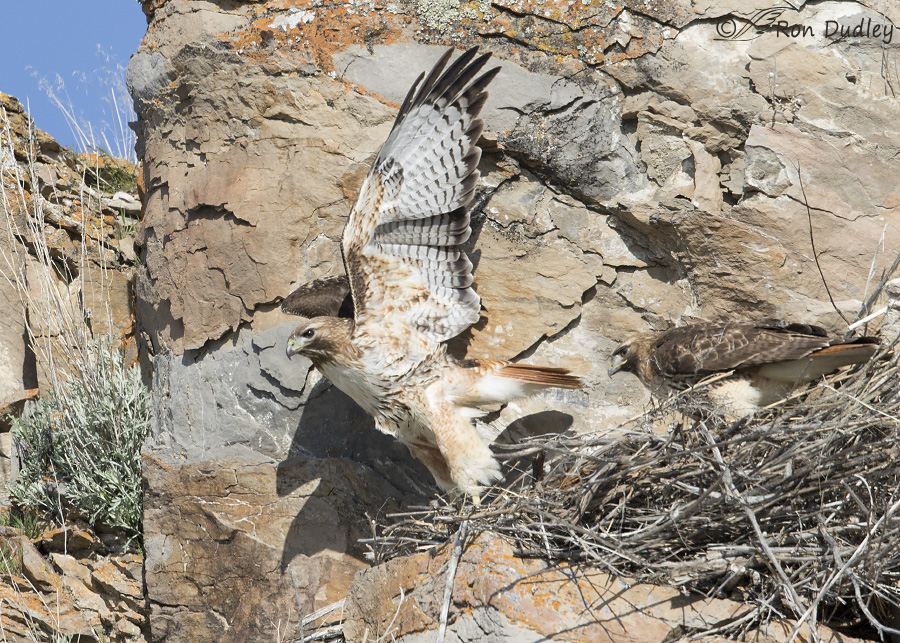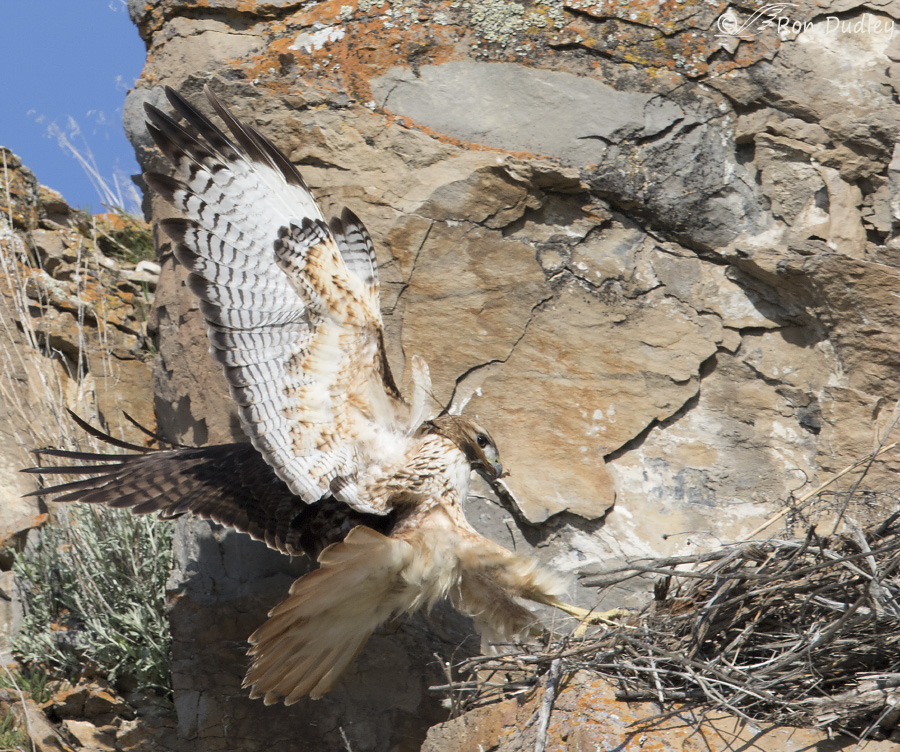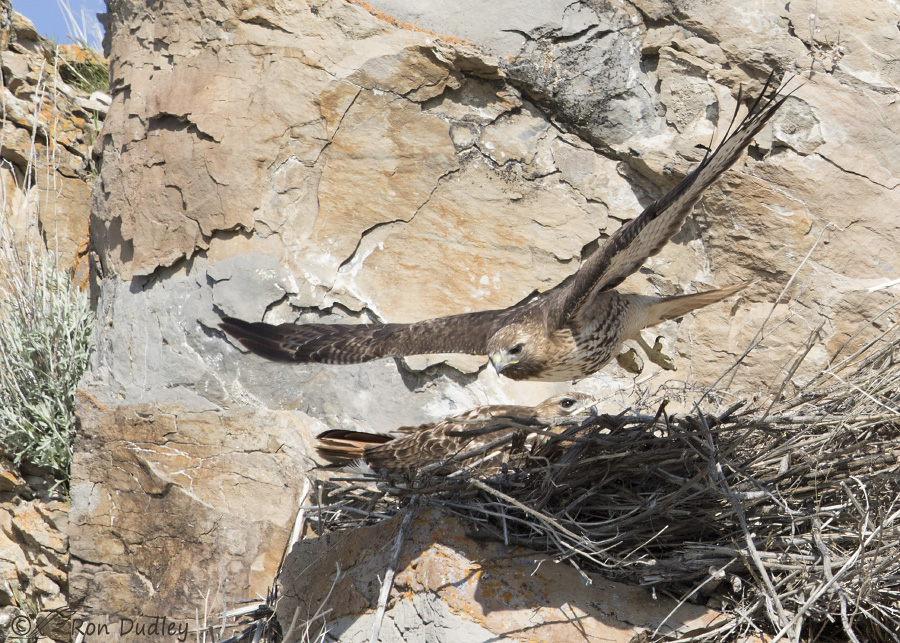This industrious pair has been refurbishing their nest for weeks.
1/2500, f/6.3, ISO 500, Canon 7D Mark II, Canon EF 500mm f/4L IS II USM + EF 1.4 III Extender, not baited, set up or called in
I photographed this mated pair of Red-tailed Hawks at their nest nine days ago in northern Utah. In a previous post of some images of the male several readers asked to see the female – that’s her on the right. On this morning both birds were bringing twigs and sticks to the nest and in this shot the male is taking off to search for more nesting material.
1/2000, f/7.1, ISO 400, Canon 7D Mark II, Canon EF 500mm f/4L IS II USM + EF 1.4 III Extender, not baited, set up or called in
Six minutes later the male returned with a delivery – this time a very small twig that’s a little difficult to see in his beak. Because of the cliff directly behind the nest these birds nearly always landed with their backs to me so this is as close as I came to getting a side view of a landing. It isn’t an ideal perspective on the bird but I decided to include the photo because I really like the “big reach” of the outstretched legs and the widely fanned tail. Notice the askew feather sticking straight up between the neck and the base of the wing.
1/1600, f/7.1, ISO 400, Canon 7D Mark II, Canon EF 500mm f/4L IS II USM + EF 1.4 III Extender, not baited, set up or called in
I thought this shot was kind of unique. We get a good look at both birds with the female watching his takeoff intently. Here the female has ducked down to avoid having her head taken off by his wing during the explosive takeoff – something she clearly anticipated. I often see the same behavior with Osprey’s at their nest. I was also happy to get both birds sharp since the male is significantly in front of the female.
I’m always very sensitive to disturbing birds of any species at their nest. But these hawks chose to build their nest adjacent to a road and they’ve become acclimated to traffic (including large, noisy trucks) and other human activities. I photographed them from inside my pickup parked on the road (I never got out) and I was using a super telephoto lens attached to a cropped frame camera and teleconverter which meant I was shooting at an effective 1120 mm – even so these images have been cropped significantly. And I watched very carefully to make sure that my presence didn’t alter their behavior or disturb them in any way.
If it had I’d have left the area immediately. The photo is never worth disturbing birds at the nest. Not ever.
Ron





Ron,
Thanks for these shots. Good advice in your post. I am amazed at the detail and clarity you get with that kind of TC and cropped sensor and then cropping the picture itself. Your shutter speed is lower than I expected. I keep reading your camera information and trying to duplicate it but you must have a magic talent or formula to achieve these magnificent results. Or maybe I just am no good. Wo is me!
Keep on posting! Love it every day.
Stephen
I’m very late today, Ron (a busy day transporting two baby owls from two different locations to rehab) and can’t believe I almost missed *my* red tails! I guess they’re determined to raise a family by the side of the road and, though I will continually worry for the safety of nestlings/fledglings, I can only believe Mom & Dad know exactly what they’re doing. Big bonus: you’ll be able to keep an eye on them for us! I am so looking forward to more photos of this beautiful pair and their family. Today’s pictures are very special.
Today’s pictures are very special.
Also want to say I’m so glad to see that Laura (Culley) is back to share her knowledge of RTHAs (and other birds). I was sure she would have been even more devastated by the loss of Ezra than we “ordinary” cam watchers because she knew him and Big Red as intimately as anyone. Appreciate reading that she thinks BR may still be mourning him (though it makes me sad) — I try not to anthropomorphize wild creatures, but it’s hard to believe that mated pairs can so easily forget that heretofore unbreakable bond. (Like the pair in these images, no doubt!) Anyway, thanks for offering a place where so many people can share their love of wild birds (and wild earth, for that matter) — and for all your fabulous images that remind us daily of the world beyond our own backyards that deserves our care and attention.
I’ll definitely be keeping an eye on them, Chris. I spent a few minutes with them this morning and they’ve settled into their routine. She appears to be on eggs and the male is keeping a watchful eye. Fingers crossed for a successful nesting season for them.
What a privilege to see. Thank you so much. For the sharing, and for the ethics.
Thank you on both counts, EC.
Thank you for demonstrating that ethics and the perfect shot are NOT mutually exclusive! If only more people understood that. The first two of the male are pretty spectacular. Wow! The third shows what perfect partners these two are in anticipating each other’s moves — sort of like the long-married couple who can finish each other’s sentences.
Marty K, it’s exactly like a long-married couple. Having watched Big Red and Ezra for the last five years, what’s abundantly obvious is that they’re an incredible team, like a well-oiled machine. Each has their part of the puzzle and they perform their tasks tirelessly. At the center of their lives is raising young, teaching them life/survival skills in little steps from the moment they’re hatched. I’ve been so impressed with their parenting skills. I’ve learned SO much from watching the Cornell cam along with the peregrine nest at the Rachael Carson Building in Harrisburg, Pennsylvania. If you get a chance to look in on a good nest cam, DO IT! WARNING: It’s incredibly addictive, but in a very good way!
Laura, I’ll have to check them out. Such a shame about Ezra. I’m definitely addicted to the DC eagle cam and I can’t imagine losing Mr. P. or TFL. I appreciate you sharing so much wonderful raptor information; I’m learning a lot. I see redtails quite often around our local spca, as they’re partial to the gophers, rats, mice, and smaller birds that hang around all the food and play yards at the shelter.
Marty, your first sentence says it all. Leave it to you to put it accurately and succinctly!
Thanks, Ron.
These are wonderful action shots of homemaking activities…I hope you always repeat those important photographers’ “birder ethics” . Although in most cases, you are “preaching to the choir”, experience tells us it hasn’t always been so…Please keep on teaching, teacher……at every chance. You never know who might be listening…..
Patty, Just so you and others here know, I don’t repeat those nest photography ethics for the benefit of my regular commenters – you’re right, that would be preaching to the choir. But regular and intermittent commenters on my blog are only a tiny fraction of my readers – most subscribers never comment. And many others find my posts on internet searches. So I repeat that ethics stuff for them – just to spread the word and hopefully make a difference for birds.
Excellent!!!
Oh just WOW! (Insert string of super superlatives here!) Yes, you’ve got me with redtails and especially nesting redtails! But that doesn’t diminish the spectacularness of these photos! In my world, there’s something special about redtail hawks.
For the last five years, I’ve been blessed and delighted to moderate the chat room with the Cornell Redtail Nestcam. We’ve been blessed to watch as an experienced pair raised 15 young hawks (three each year). What a special time!
Sadly, this year, the male, Ezra, was killed in unknown circumstances. Ezra was at least 11 years old and an outstanding mate, parent, hunter and overall redtail who touched everybody’s heart in so many ways. The female, Big Red, hasn’t yet chosen another mate but has thus far retained the territory. So no up-close-and-personal baby hawk watching this year.
Big Red was banded as a first-year bird in 2003, so in redtail terms, she’s pretty old and her choices of available mates would necessarily include males who are much younger with little to no experience in raising families. While she’s been seen soaring with other redtails, she hasn’t settled down with anybody yet and the window of opportunity for nesting is closing rapidly for this year if it isn’t already closed. I’ll certainly hope that the Cornell redtail hawk nest is renewed again next year. Over the years we watched Big Red and Ezra beginning in 2012, they’ve raised at least 15 young hawks to fledge, three each year, however, that number is probably higher. We just started watching in 2012.
That she hasn’t chosen another mate is somewhat surprising to me. It leads me to speculate (SPECULATE!) that perhaps she’s mourning the loss of Ezra. They were together a lot of years and Ezra was a seriously excellent mate. Of course there’s no way to KNOW unless we could crawl into her mind (and that’s not happening until Merlin shows up with a working magic wand!), but it’s fun to speculate. I believe that we are far more alike than we are different and it’s certainly not out of the realm of possibility that, like elephants (and other species), they’re far more sentient/intelligent than we humans have been willing to believe in the context of they’re just dumb animals! Having spent almost 25 years with Mariah (female redtail hawk), I know it that to be true! But you’ve got to LISTEN. We humans aren’t good at that.
On the good news front, I’ve got a pair of nesting redtails on a platform along the highway to Kingman, however, all I’ve gotten is glimpses of the female who is obviously sitting on eggs since I’m limited by that and-driving thing. Folks on a four-lane highway expect you to keep going at speeds that are inconvenient for bird watching. Yes, I can pull over on the side of the road, but it’s not available to get a good look into the nest given its height. Harrumph! That darn and-driving thing thwarts me regularly. What’s wrong with people? Don’t they know that bird watching is far more important than zooming by wondrous birds making more birds? Sigh…
You know how much I applaud, appreciate and respect your wildlife ethics. In so many ways, you just rock! Thank you for being you!
Sorry about the loss of that bird! Sad. Please remember that not only do we not know what goes on in an animal/bird mind, we really don’t know what goes on in anoother human’s mind, either. We can guess, but never REALLY know. It certainly appears that animals care for each other, much as we do…and miss thrm when they are gone…Do we need to “know” more???
Patty, there are thousands of folks who are just devastated at Ezra’s death. He was a studly dude, one spectacular redtail who caught all sorts of things that redtails can’t possibly catch like pigeons, doves, sparrows, robins, starlings, an assortment of other little birds, along with a ring-billed gull for pity’s sake! He had mad hunting skills. As soon as the first egg hatched each year, he’d lay out a smorgasbord of goodies, stocking the pantry with a variety of options so that Big Red was never at a loss to critters to feed the kiddos. All she had to do was decide what was for dinner tonight! Their kids never knew the idea of hunger until possibly a long while after fledging. In short, he left some HUGE talons to fill! He’d have made me look really good as a falconer…but Mariah did that, too. She made me look like I had any idea what I was doing. LOL!
He’d have made me look really good as a falconer…but Mariah did that, too. She made me look like I had any idea what I was doing. LOL!
He was also just beautiful (yeah, I know). I often said I’d have been delighted to have flown him as a falconry bird, but he was serving a MUCH higher purpose. Still, I fantasized about that regularly
Laura, as I’m sure you know the internet was abuzz with the news of Ezra’s death for some time after it happened. He must have been one of the most famous hawks in the world. I love knowing that so many people from so many places cared about that bird. That kind of thing tends to spread and that’s a good thing.
Like you, I believe the education part of this is vitally important. We don’t protect/care for what we don’t know and we’re often fearful of what we don’t know. Ezra had a cast of thousands of fans, and along with Big Red and their kids, they let people into their worly by the grace of Cornell’s Lab of Ornithology. I’ve been so very blessed to channel redtail hawk information from Mariah to inform so many people on the Cornell chat and what a special joy that is. Ezra and Big Red also rewrote a lot of information in the books that just didn’t pertain to their reality That was special, too!
That was special, too!
Another nice group of photographs! I like your reiterations of bird photography ethics. It keeps reminding us, me as a beginning bird photographer and others more experienced, to watch ourselves in our eagerness for the “great shot”.(Do you get tired hearing us exclaim over your work? Does it get tedious?)
Nope, never get tired of it, Joanne… Sure beats the alternative – “crappy shot, Ron”.
Haha. Yes, I guess it would!
Ron. Wonderful shots of both. Males feather pattern perfect in first frame.
I think both male and female knew just where each was in the male take off frame. Bonded pair indeed. Thank you
I’m sure they did know each other’s position exactly, Diana. No question in my mind.
Excellent shots Ron! The lack of catchlight is not a problem with me, either in the second shot or third, especially when the female is shown under his wing and the catchlight is in her eye.
It will be interesting to see how they will react to traffic once the eggs are laid and or the chicks hatch.
Dick, I saw them both this morning for a few minutes and it appears the female is now on eggs. I hope it all goes well for them.
Gorgeous! In the first photo the female blends in so well I had to look for her! The third shot is great getting both birds clearly! Nicely don, Ron.
The third shot is great getting both birds clearly! Nicely don, Ron. 
Thank you, Judy.
I so appreciate your conscientiousness when you photograph these magnificent birds. I’m quite wowed by photo #3, too! Almost takes the sting out of watching hawks fly off with small birds when one can actually see the nest where the young will be nourished…
Alison, Thanks for that feedback on #3. I wasn’t sure how that image would be received because of the lack of a catch light in the male.
That third image is perfect in every way Ron….I love it!
Tim
Thanks very much, Tim.